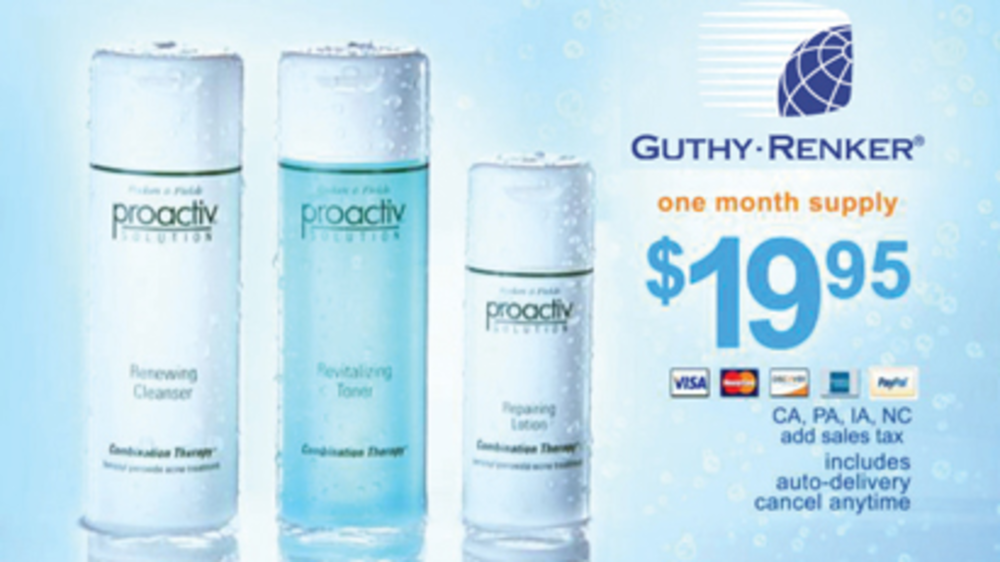“We love our model now more than ever,” says Greg Renker, co-CEO of Guthy-Renker Products, the longtime marketer of mostly health and wellness products through DRTV. “The ability to use data to your advantage competitively is more powerful than ever.”
But this success, Renker adds, has contributed to an uptick of competition in the channel.
“There are fewer large-scale buys and more microbuys,” Renker explains. “We used to spend $40,000 is on 20 two-minute commercials all airing at the same time with different offers and creative. There may be four or five different Proactiv offers airing on the same day — we could never do that 10 years ago.”
The standard formula of a spot or an infomercial hasn’t really changed, says Jeff Meltzer, the CEO of DRTV agency Meltzer Media and chairman of the PR committee for the Electronic Retail Association.
“The only thing that’s changed is the offer,” he says. “It used to be, ‘Take this thing now for X amount of dollars and we’ll bill you every month until you say no’ — that’s not legal anymore. But what’s legal now is, “We won’t charge you for 30 days, and if you don’t like it, send it back.'”
Most credit the advent of cable television in the mid-1980s with providing more opportunities for DRTV to show off its effectiveness as a channel that leads to sales. Dick Wechsler, the president and CEO of DRTV agency Lockard & Wechsler Direct, whose clients include Blue Cross Blue Shield, Sears and Fidelity Investments, notes that Ted Turner once told the Cabletelevision Advertising Bureau how DRTV was instrumental in lending credence to cable television in its early days.
“Turner [Broadcasting] used to be very aggressive in making their inventory available to DR advertisers on a per inquiry or a per order basis, Wechsler remembers. “In the days when Nielsen didn’t rate cable, the way CNN and Headline News were able to persuade brand advertisers that the inventory had value was to take all the per inquiry data that was generated by direct response advertisers and share it. As cable has grown, DRTV has grown in lockstep. The industry’s always inventory starved, so the more inventory that’s available the better.”
DRTV’s success with the expanded inventory led more marketers to use it. QVC, the 24-hour home shopping network that launched in 1986, went through some growing pains trying to get big-name brands to sell on it.
“In the early years, our merchants often struggled to convince manufacturers and brand marketers of QVC’s relevance,” says Doug Rose, VP of multichannel programming for QVC. “In recent years, many of the world’s most prestigious, progressive brands now look to QVC as the ideal launchpad for their latest technologies and designs.”
Today, consumers might not even know when they’re watching a DRTV ad for a bigger brand because these ads don’t fit into the established perception of the medium, Jeff Meltzer, CEO of DRTV agency Meltzer Media and chairman of the PR committee for the Electronic Retail Association points out — but those brands keep returning to the channel because of its effectiveness.
“When you look at P&G and Verizon and Lever Brothers, they incorporate DR into their yearly budget,” he says. “But they’re not selling a PedEgg or a HeatSurge. Most of the time it’s a service or an offer. It’s Madison Avenue-based direct response.”
A third of QVC’s sales come through the Web, and some DRTV ads now encourage Internet rather than phone sales. Incorporating these e-commerce elements has changed the way DRTV is measured.
“Ten years ago, we controlled 10,000 1-800 numbers,” Renker explains. “Now, it takes longer to determine the source of an order from the Web. We are generating a lot of traffic flow, but capturing that customer and getting him or her to enter their order information is a challenge.”
With all these developments, DRTV practitioners are sure of its place in the marketing mix. The channel stays true to direct marketing’s key tenets of targeting, offer and data, while still evolving.
“There are five categories that will always sell: weight loss, exercise, beauty, get rich quick, instant miracle,” Meltzer says. “It’s based on data. And the data is based on how many people call, order and what they spend. It’s still about a problem, solution, and a great offer to entice people to react.”








